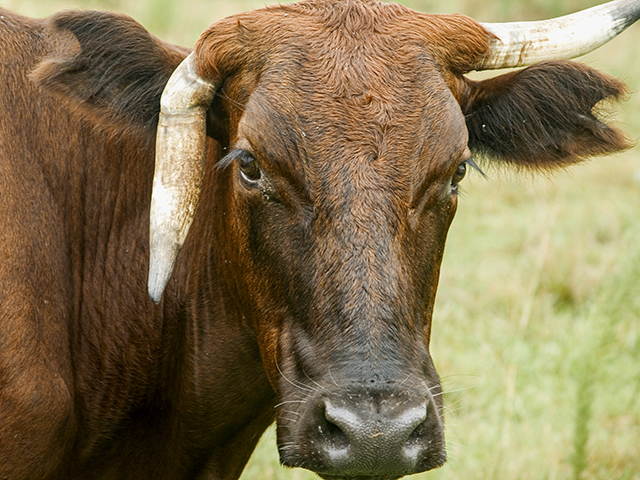Ask the Vet
Avoid Adult Cow Dehorning
READER: We have a cow we missed dehorning as a calf. She is 4 years old and has started using those horns on other cows around the feed trough and hay ring. I've read about removing horns with a bander, but I've never done this. I'm not even sure it will work. What do you suggest?
Dr. McMillan: There is no good way to dehorn a mature cow. I have used the old Keystone-type dehorners in the past but will never do that again. It is just not humane in my opinion. I have tried bands on two occasions without success. There are also reports on complications and delayed bleeding and infection as the band slowly cuts through the horn. I would be interested in hearing others' experience -- both good and bad -- using bands, but at this time, I would not recommend them.
One option is cosmetic dehorning, but this is not a cheap option. It's a surgical procedure done by a veterinarian using a mild tranquilizer/pain reliever combination and local anesthesia. The skin is cut away from the base of the horn, and a Gigli wire saw is used to cut the horns smooth with the skull. After controlling the bleeding, the skin is sutured back over the hole.
I have had excellent results with this method, and the cattle look polled after they heal. With good pain management, including nonsteroidal anti-inflammatory drugs (NSAIDs, including flunixin, meloxicam, etc.), during and after surgery and control of infection and flies, cattle do very well with little or no setback.
A less-expensive and invasive option is to "tip" the horns by cutting off 1 to 2 inches. If more than this is removed, both the nerve and blood supply are affected, and it opens the hollow portion of the horn, which directly connects with the sinuses. Infections and maggots can be a problem. It is also extremely painful, so I feel very strongly that these animals need aggressive pain control. Bleeding must be controlled, also. There are many techniques that have been used to control bleeding, including hot irons, round toothpicks into the bleeders in the horn, applying a pressure wrap of gauze taped to the horns and a figure eight tourniquet around the base of the horns (which must be removed).
P[L1] D[0x0] M[300x250] OOP[F] ADUNIT[] T[]
Tipping has drawbacks. While cattle are less dangerous and unlikely to create puncture wounds or put out eyes, they can still use the horns as a weapon, leading to bruising and creating issues around the feed bunk or hay ring.
I am a huge advocate for aggressive pain management with any painful procedure in livestock. Even a hot dehorning iron on calves is painful. Local anesthetics are economical and easy to use. NSAIDs are safe and highly effective in controlling postoperative pain.
We are stewards of the animals under our control, and pain management is the right thing to do. I also believe it's in a producer's best economic interests. Pain cost pounds, and pounds are money.
Lastly, while this is not your question, as you move forward with your herd, consider a genetic solution to the dehorning issue. I am a breeder of Polled Herefords, so I have seen firsthand the value of polled genetics to the elimination of this stressful and costly procedure.
READER: We run 200 to 250 head of cows, sorted into groups of 50 head. We run two bulls per herd. When breeding season is over, we pull out the bulls. We always have lots of fighting between bulls. This year, we lost a bull after he tore up a knee fighting. Do you have suggestions on how to minimize fighting and injury?
Dr. McMillan: Even if the same bulls were together before breeding season, there will be fighting when they are reintroduced. Bulls develop a social order that is always being challenged. When reintroducing bulls, never mix them in a small area, especially not on concrete. This can be extremely dangerous to bulls and to humans.
A pasture should be large enough for bulls to fight without getting into fences, buildings, equipment or other dangerous objects. The loser should have a place to escape. One report suggests at least 2 acres per bull to reduce fighting and injuries. Spread out feeding areas, water and shade. Keeping bulls in adjacent pens separated by an electric fence with at least 4000 volts for several days may help acclimate bulls before mixing them. Feeding them during introduction may distract some bulls.
Mixing mature and small bulls together first, then blending groups may help. Putting just one new bull into a group should be avoided. Instead, pair a new bull with another first, then gradually add both to a small and then a bigger group.
I would appreciate hearing from others on how they handle this issue.
**
-- Please contact your veterinarian with questions pertaining to the health of your herd. Every operation is unique, and the information in this column does not pertain to all situations. This is not intended as medical advice but is purely for informational purposes.
-- Write Dr. Ken McMillan at Ask The Vet, 2204 Lakeshore Dr., Suite 415, Birmingham, AL 35209, or email vet@progressivefarmer.com.
[PF_1021]
(c) Copyright 2021 DTN, LLC. All rights reserved.




